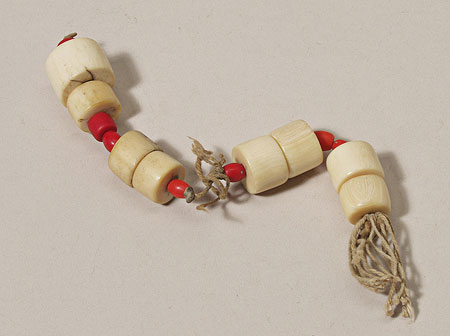Accession Number:
1934.8.103
Country:
Sudan
Region:
[Southern Sudan] ?Western Bahr el Ghazal ?Warab Kornuk
Cultural Group:
Rumbek Jur
Date Made:
By 1933
Materials:
Animal Ivory Tooth , Glass , ?Plastic Synthetic , Plant Fibre
Process:
Carved , Moulded , Strung , Twisted , Tied
Dimensions:
Total L = 215 mm, L as hung = 113 mm, Plastic beads diam = 6 mm, L = 9 mm; glass bead diam = 8.5 mm, L = 7 mm; ivory bead minimum diam = 5.8 by 5.3 mm, min Ht = 11 mm; largest ivory bead diam = 21.3 by 21 mm, Ht = 14.8 mm; diam string = 1 mm [RTS 3/6/2004
Weight:
42.9 g
Local Name:
muja
Other Owners:
Collected by Percy Horace Gordon Powell-Cotton and his wife on 25th May 1933 during a shooting expedition.
Field Collector:
Percy Horace Gordon Powell-Cotton & Hannah Powell-Cotton (nee Brayton)
PRM Source:
Percy Horace Gordon Powell-Cotton
Acquired:
Donated 1934
Collected Date:
25th May 1933
Description:
Hair ornament made from two short lengths of twisted light yellowish brown plant fibre string, probably cotton (Pantone 466C), knotted together at the top.
Each length has been strung with a series of opaque red elliptical plastic beads (Pantone 7417C), large ivory disc shaped beads (Pantone 7401C) and small opaque red glass disc beads (Pantone 187C), secured in place by a knot at the end of each string.
They are not strung identically.
The left string has a single red plastic bead, 2 ivory beads, 2 red plastic beads then 2 further ivory examples, with a tassel hanging from the end.
This tassel has been made by knotting short lengths of twisted fibre around a central ring, that sits just above the end knot.
The right string has 1 plastic bead, 2 ivory beads, 1 plastic and 1 glass bead, 2 ivory beads, one of which is considerably larger in size, and then another glass bead.
The plastic beads appear to have a seam running down their sides.
It is not clear whether the object is complete, or whether there was originally a tassel on the end of both strings.
Some of the ivory beads have surface cracks.
If stretched out to its full extent, the ornament has a length of 215 mm; if hung from the top knot, it has a maximum length of 113 mm.
The red plastic beads vary slightly in size, with one example having a diameter of 6 mm and a length of 9 mm; the red glass beads have a diameter of 8.5 mm and a length of 7 mm, while the smallest ivory bead measures 5.8 by 5.3 with a height of 11 mm, and the largest measures 21.3 by 21 with a height of 14.8 mm.
The string has a diameter of around 1 mm, and the ornament weighs 42.9 grams in total.
Collected by Percy Horace Gordon Powell-Cotton and his wife Hannah at Kornuk on 25th May 1933, during a shooting expedition. The location of Kornuk suggests that the cultural group involved are the Rumbek Jur.
This ornament was worn at the back of the hair, and is known as muja. The red beads are said to be trade beads.
This object is currently on display in the Lower Gallery, case 104A.
Rachael Sparks 25/9/2005.
Collected by Percy Horace Gordon Powell-Cotton and his wife Hannah at Kornuk on 25th May 1933, during a shooting expedition. The location of Kornuk suggests that the cultural group involved are the Rumbek Jur.
This ornament was worn at the back of the hair, and is known as muja. The red beads are said to be trade beads.
This object is currently on display in the Lower Gallery, case 104A.
Rachael Sparks 25/9/2005.
Primary Documentation:
Accession Book Entry
[p.
248] 1934 [insert] 8 [end insert] -
MAJOR P.
H.
G.
POWELL-COTTON
, Quex Park, Birchington, E.
Kent.
Specimens collected by himself & Mrs Cotton, during hunting trips, 1933, viz: [...] [p.
258] - From the
JUR
tribe, LUKLUN and KORNUK.
[...] [insert] 103 [end insert] -
Muja
, pair of strings of large ivory beads & red trade beads, worn at the back of the hair, KORNUK (2682).
Card Catalogue Entry - There is no further information on the catalogue card [RTS 27/4/2004].
Pitt Rivers Museum label - Muja pair of ivory-bead tassels worn at back of hair. JUR. KORNUK, E. SUDAN 7 [degree] 53' N., 28 [degree] 9' E. d.d. Major Powell-Cotton, 1934 [L.Ph 'DCF 2004-2006 What's Upstairs?' 6/6/2005]
Related Documents File - Typewritten List of "Curios Presented to Dr. Balfour by Major & Mrs. Powell-Cotton. Jur Tribe". This object appears as item 2682: "Pair ivory bead tassels, bought, worn at back of hair, native name Muja, 25/5/33 Kornuk, 7.53 N 28.9 E”. Also contains details of a cine film 'some tribes of the Southern Sudan', taken by Powell-Cotton during this 1933 expedition, copies of which are now in the National Film and Television Archive and the Powell-Cotton Museum in Kent [RTS 14/3/2005].
Card Catalogue Entry - There is no further information on the catalogue card [RTS 27/4/2004].
Pitt Rivers Museum label - Muja pair of ivory-bead tassels worn at back of hair. JUR. KORNUK, E. SUDAN 7 [degree] 53' N., 28 [degree] 9' E. d.d. Major Powell-Cotton, 1934 [L.Ph 'DCF 2004-2006 What's Upstairs?' 6/6/2005]
Related Documents File - Typewritten List of "Curios Presented to Dr. Balfour by Major & Mrs. Powell-Cotton. Jur Tribe". This object appears as item 2682: "Pair ivory bead tassels, bought, worn at back of hair, native name Muja, 25/5/33 Kornuk, 7.53 N 28.9 E”. Also contains details of a cine film 'some tribes of the Southern Sudan', taken by Powell-Cotton during this 1933 expedition, copies of which are now in the National Film and Television Archive and the Powell-Cotton Museum in Kent [RTS 14/3/2005].



